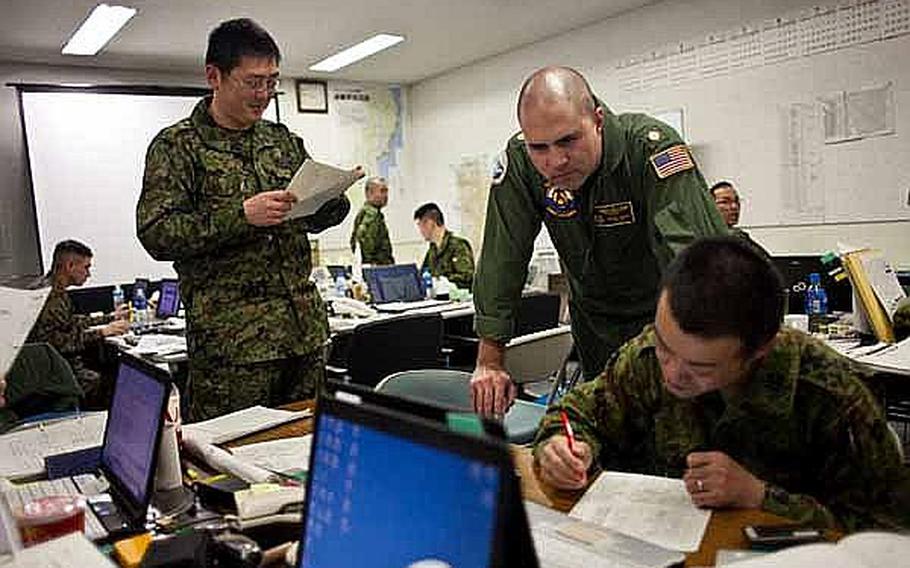
Lt. Cmdr. Barnet Harris, assigned to the Bilateral Crisis Action Team at Camp Sendai, Japan, works with Japan Self-Defense Force troops to coordinate U.S. and Japanese relief efforts. (Nathan A. Bailey/Stars and Stripes)
SENDAI, Japan – U.S. and Japanese troops have recovered 58 bodies since launching a massive joint operation to search for the thousands of people still missing after the March 11 earthquake and tsunami, according to Japanese officials.
Seven thousand U.S. servicemembers and 18,000 Japan Self-Defense Force troops are participating in the operation, which is expected to wrap up Sunday evening.
U.S. ground forces are not involved in the search, which covers Pacific coastal areas in Iwate, Miyagi and Fukushima prefectures, as well as waters up to 12 miles off shore, according to Marine spokesman 1st Lt. Nicklaus Eisenbeiser. U.S. forces participating in the operation are being lead by the Navy’s 7th Fleet, which is providing aerial search support, he said.
“By mobilizing 120 airplanes and helicopters and 65 vessels from both militaries, the three-day operation will be conducted along jagged coastline and off shores of the stricken areas, except for the 12-miles restricted zone surrounding the Fukushima No. 1 nuclear power plant,” a JSDF spokesman said Sunday.
U.S. Navy Lt. Commander Barnet Harris, 32, of San Jose, Calif., an officer working to coordinate U.S. and Japanese military efforts in the “Bilateral Crisis Action Team Room” on a JSDF base in Sendai, said Saturday that the U.S. is providing support in the search for bodies at sea. Harris said although the militaries are now searching for dead bodies at sea they are officially referred to as “missing persons”.
A U.S. military liaison officer working with Japanese troops in the field in northern Japan, Marine Capt. Adan Maldonada, 33, of El Paso, Texas, said American personnel take a hands-off approach when they come across dead bodies.
For example, troops removing debris avoid using heavy equipment such as bulldozers where possible, he said.
“As we are doing it there is a lot of sensitivity because there are human remains mixed in with the debris,” he said. “You can’t just scoop the debris up with a dozer and dump them. You have to sift through it and clear it.”
U.S. troops working with a Japanese unit clearing a school playground found a man’s body during clean up operations Friday, Maldonada said.
“We just stopped, and the Japanese took him,” he said.
Officers tell soldiers and Marines who find a body: “Stop what you are doing and grab a senior JSDF official on the ground,” he said. “There is no taking photographs and hanging out. Move away from the area and let the Japanese handle it.”
Japanese Coast Guard, police and fire agencies are also participating in the search operation, the JSDF spokesman said.
According to the Japanese Police Agency, 12,009 people were confirmed dead and 15,472 people are unaccounted for as of Sunday.
In Miyagi, one of the hardest hit prefectures, 7,318 people were killed and 6,329 people remain missing. In Iwate prefecture 3,518 are dead and 4,513 people are missing.
Stars and Stripes reporter Chiyomi Sumida contributed to this report.